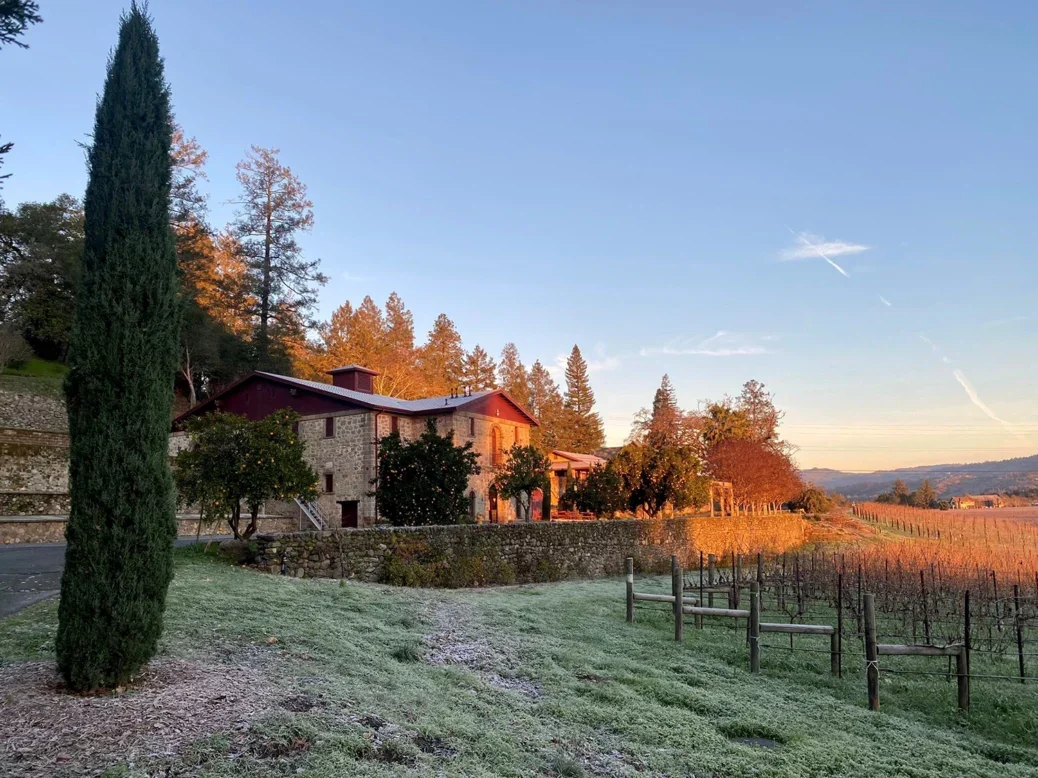
There are more than 25 French-owned wineries in Napa Valley, and dozens more retain French consultants or have French-born winemakers. Their influence is considerable, and they are mainly a welcome presence. As Roger Morris reports, this peaceful French invasion seems likely to continue.
Young Bernard Portet had just mustered out of the French army in 1970 when a friend hooked him up for a job interview with the Goelet family, who, as they collectively remember, “dreamed of founding a winery outside the insular world of the French wine industry” and were looking for someone to scout out a New World wine estate. Portet was not an unusual candidate, since his father, André, had been régisseur at Château Lafite Rothschild; but nevertheless, “I was surprised when at the end of the interview, Mr Goelet asked, ‘When can you start?’” Two years of searching and three continents later, Portet found himself in California.
“I tried Napa Valley, but I found the wines were too alcoholic. Then I was driving down Silverado Trail through Stags Leap, and I noticed the air was cooler,” he says, remembering where the two-lane highway—after it snakes through rugged countryside beneath the sheer cliffs of the Leap itself—begins sloping down toward San Pablo Bay. “I thought, ‘If I can’t have cool days, then I can have cool nights to make my wines fresher.’” The property on the east side of the road that caught Portet’s eye wasn’t even planted with grapes but instead was growing prunes, walnuts, and alfalfa—hardly classic French terroir, one might have thought. In spring 1972, the new owners and the new winemaker at the new Clos du Val winery planted 50 acres (20ha) of Cabernet Sauvignon vines. Just that quietly, the French invasion of Napa Valley had begun.
Today, there are more than 25 Napa Valley wineries that have French owners, a new one being added almost annually. Even more wineries retain French wine consultants or have French-born winemakers. In fact, one could create a parlor game matching French owners and their Napa country estates:
In column A, in no particular order, are owners of these French properties: Petrus, Moët & Chandon, Château Smith Haut Lafitte, Domaine de la Romanée-Conti, Château Mouton Rothschild, Château Latour, Château Cheval Blanc, Bouchard Aîné & Fils, Château Pontet-Canet, Taittinger, Château Rauzan-Ségla, and GH Mumm.
Now, match column A owners with these column B Napa Valley estates: Joseph Phelps, Opus One, Araujo (now Eisele Estate), Domaine Chandon, Domaine Carneros, Mumm Napa, Hyde de Villaine (co-owner), Raymond, Dominus, St Supéry, the former Flora Springs estate but not the brand (now Cathiard Estate), Ulysses, Pym-Rae, Newton, Outpost, Elizabeth Spencer, and Sullivan.
And if you happen to be dining or shopping in one of the valley’s small towns, you may spot Bordeaux-based wine consultant Michel Rolland on one of his three annual trips to visit his 21 wine clients in the valley. Or perhaps Stéphane Derenoncourt. Or even more likely, Philippe Melka, noted for his cult-winery clients and for going native by putting down roots in the valley. Then there is Philippe Bascaules, who occupies the rare position of simultaneously directing both Château Margaux in Bordeaux and Inglenook in California.
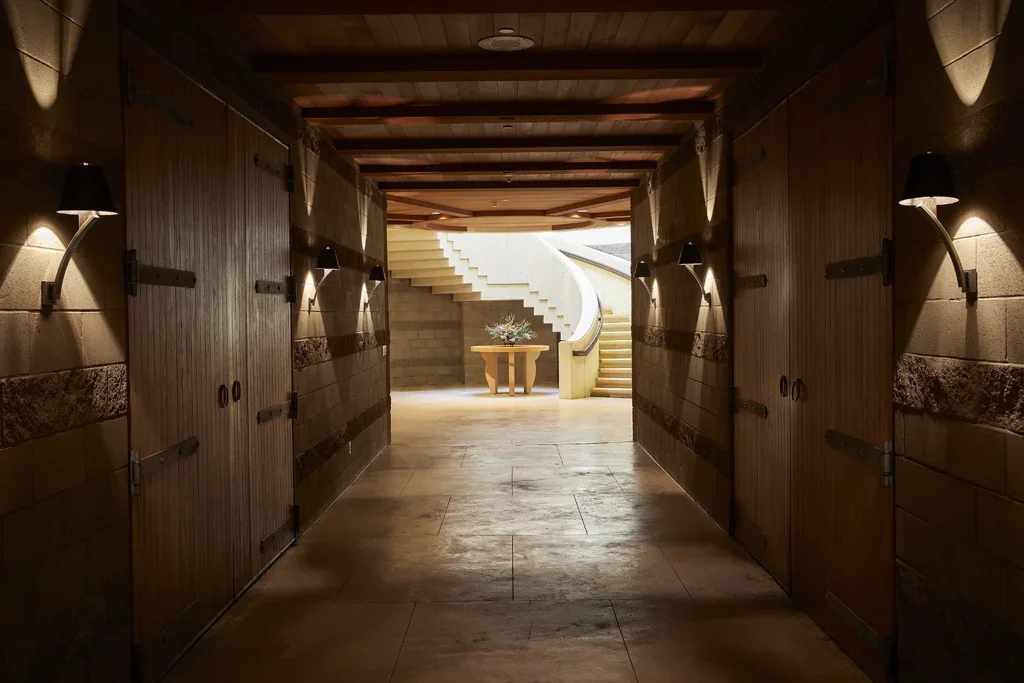
The French establish a beachhead
If there was a Golden Age in Napa Valley, it was the 1970s. At the beginning of the decade, wineries were mainly small family businesses making good wines, but still largely ignored by fine restaurants in nearby San Francisco, who preferred to list Bordeaux, Burgundy, and Champagne. Then, led by an unchained Robert Mondavi and aided by an influx of new money and new owners (few with any tangible wine experience), by 1980 Napa Valley was suddenly the place to make fine wines and invest in wine properties.
To his surprise, Portet felt welcomed in the valley, the new kid in town. “In Bordeaux, they played everything close to their chest, keeping secrets to themselves,” he says. “Here, you would go to a meeting with Robert Mondavi, André Tchelistcheff, Chuck Harvey—and they would share everything! I was surprised when Ric Forman came back from a trip to St-Emilion. He got out his notebook and read us everything he had learned. It was a very friendly attitude.
“Then, in 1974, I bought a French press. I was afraid the motor would burn out, but the salesman said, no, it wouldn’t. It burned out. This was on a Friday, and a friend I barely knew then, Frank Mahoney, brought a small press over on a trailer so I could press the rest of the tank. Another time, a pump broke down. The cellar master at Mondavi lent me theirs. He said, ‘Bernard, you can have the pump, but don’t let it break down. I need it tomorrow.’”
As Portet was planting his grapes, steps were being taken for the entry of the first established French winery—the kind whose investments draw headlines—into Napa Valley. Already, French winemakers in classic terroirs had begun investing and expanding—new wine colonies, as it were—having left their vineyards in North Africa following the colonial wars. Champagne makers, complaining demand was exceeding grape supply, had been looking overseas. In 1959, Moët & Chandon boldly invested in a sparkling-wine facility in Argentina.
The same spring of 1972, John Wright, a consultant with AD Little, had just completed a US wine marketing study financed by several major corporations eyeing the sector, as well as by Robert Mondavi. As fall was approaching, a colleague of Wright’s set up a dinner meeting in Paris with Robert-Jean de Vogüé of Moët. The two quickly set about convincing the rest of Moët’s corporate structure to look at the US.
As talks progressed, Wright was amazed by the daring of his soon-to-be partners. In a 1991 oral-history interview for the Bancroft Library at UC Berkeley, Wright recalled, “The [Moët] focus wasn’t on how to avoid risk or to be risk-free; the focus was, ‘Is there an opportunity here?’ I didn’t understand it at the time. I was, frankly, a little amazed. They never asked to see my study.” Wright was even more amazed when he was asked to head Chandon’s Napa venture.
In March 1973, the new company was announced. The process of finding space and buying grapes, however, was not a glamorous one. In a related interview, Edmond Maudière, Chandon’s enologist, remembered, “When we started, we had no winery. It was like experiments in a garage—John Wright’s garage on Mount Veeder… There were a few bottles and several blends. It was an office, a cellar, the lab.” The first of Chandon’s wines were made at nearby Trefethen, while Chandon’s winery and restaurant were being finished in Yountville. The Frenchification of Napa Valley was now in full steam.
Paris and its aftermath: Mouton and Moueix
Chandon might have been a flash in the pan had Paris shopkeeper Steven Spurrier not decided to show his elite clientele that America was producing some pretty good wines. Tasting trips were made to Napa and the Bay Area. Bottles were shipped—even Portet sent along a first Cabernet—but the Californians didn’t give it much thought. It wasn’t as though it were the influential Orange County Fair, where gold ribbons would sell more wine.
Spurrier himself didn’t expect much. It would be a blind tasting, of course. The jury of French men and women would have impeccable credentials. Representative great French wines—red Bordeaux and white Burgundy—would be tasted alongside their California varietal counterparts—Cabernet Sauvignons and Chardonnays. That was the extent of it.
And that most likely would have been the end of it—except three things happened. First, the California wines took first place in both categories. Second, although only one writer could be lured to the tasting, it was George Taber of Time magazine, and his brief report appeared in what was then the world’s most influential periodical. And third, Spurrier was savvy enough to recognize what he had on his hands and refused to return scoring sheets when some of the French judges demanded them.
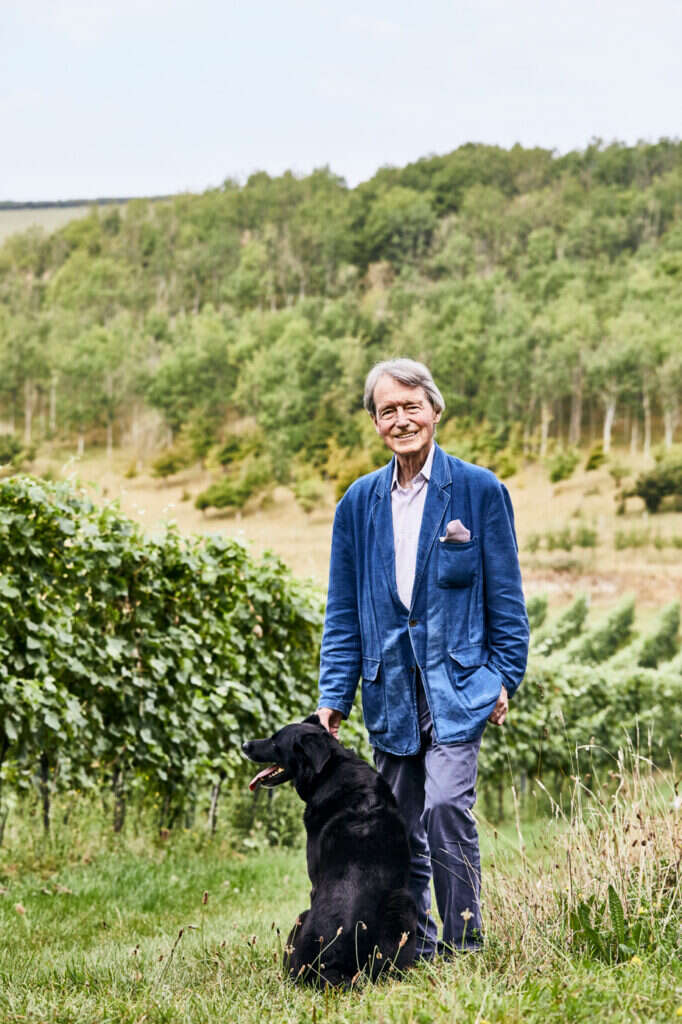
The long-range impact of the tasting and the publicity surrounding it cannot be overstated. In America, even people who never drank wine suddenly felt vindicated and the equal of the snooty French. French reaction was mixed. Some of the French judges and others in the wine establishment made excuses for their wines’ poor performances. “According to Spurrier,” Taber wrote in his 2000 book Judgment of Paris, “Lalou Bize-Leroy, the coordinator of DRC, told her co-director, Aubert de Villaine […] that he had personally put back the progress of their great vineyard by one hundred years!”
Young de Villaine was one of Spurrier’s judges, and he saw things differently, picking a California wine, the Chateau Montelena Chardonnay, as the best white, and Château Montrose as the best red. He told Taber following the event, “I tasted my first California wines in 1964, and since then there have been more and more good wine houses there.” At a minimum, the results of Paris piqued the curiosity of the more adventuresome French owners, especially the Bordelais.
One of them, Baron Philippe de Rothschild, had met Robert Mondavi at an event in Hawaii in 1970, and the two had chatted, perhaps idly, about partnering a winery in Napa Valley. About eight years later, they decided to get serious. Both men had by then received major boosts to their businesses. In 1973, Baron Philippe, who had fought to raise Mouton Rothschild from second- to first-growth status, managed, against all the odds, to do so. And Mondavi had received a financial boost in his fight with his brother, vintner Peter Mondavi, over what Robert was legally due when he was kicked out of the family business—a half-million dollars and 250 acres (100ha) of the To Kalon Vineyard in compensation.
After being royally entertained at Mouton, Mondavi hashed out with Baron Philippe an agreement to create what was called “Napamedoc,” later changed to “Opus One.” Key provisions were 50–50 ownership, and Mondavi would provide grapes and a winery for the first vintage. Later Opus would get its own vineyards and space-age winery. Mondavi made his ambitions for the venture known in handwritten comments on an early document of “fundamental principles” of the new venture. While Chandon might not have expected its Napa Valley sparkler to challenge its Champagnes in quality, Mondavi thought larger. To a sentence about producing “Napa Valley red wine,” he appended “from CS [Cabernet Sauvignon] grapes—w/characteristics of a Ier Cru Bordeaux wine!” Opus One produced its first vintage in 1979, one year after its founding.
Although perhaps unnoticed externally, things did not go smoothly internally—not just initially, but for its first quarter century, according to David Pearson, who ran Opus from 2004 to 2020. “Had either family owned 51 percent, they would have bought the other out,” he said recently. “For the first 25 years, there were two of everything—two CEOs, two winemakers. They would argue over every point before they finally agreed. A consultant was brought in in 1999 for the future of Opus, and it was recognized the structure needed to change to end the futility.” A single management system, reporting to an arm’s-length board, was installed.
“The core cultures were very different,” Pearson says. “Americans are about products and results. The French are the opposite—they focus more on the process, and it matters often more that the results. Either can be excessive—shoot from the hip versus analysis paralysis. I arrived in June 2004, and I like to use the metaphor that Opus One was the child of nobility. Now it was old enough to metaphorically leave home.”
Mondavi also had a hand in setting in motion the other blockbuster Bordeaux–Napa venture of the era. It began with Christian Moueix, the scion of the Right Bank family of growers and merchants, who had attended graduate school at the University of California at Davis at a time when a foreign wine education was unusual for the French. Moueix joined the family business, Jean-Pierre Moueix, in 1970, but he also wanted his own properties and wanted them outside of France. He looked at California but didn’t find a fit. He decided to contact Mondavi about a place in Australia, Leeuwin, in which Mondavi was involved at the time. Mondavi urged him not to give up on Napa.
Robin Lail worked with Mondavi in the late 1970s, and Mondavi thought she might have a solution. “After the conversation [with Moueix], Mr Mondavi came out and said to me, ‘Well you have a vineyard.’” Indeed, she did. Although her father, John Daniel, had sold Inglenook winery, which her grandfather founded in 1879, she and her sister Marcia Smith retained ownership on Napanook Vineyard in Yountville, just south of Mondavi’s Oakville property.
“We had been selling our grapes to the Mondavi winery,” Lail says, but Mondavi was willing to give them up to help launch her wine career. In 1982, the two sisters joined Moueix in creating Dominus. Lail laughs, saying, “For me, the opportunity to partner with Christian was as good an opportunity as you could get.” A rarity in a region where a winery’s image is almost as important as the wine, for 13 vintages Dominus was made at a contract facility—Rombauer—until 1996, a year after Lail and her sister sold Moueix their shares to create Lail Vineyards.
These investments by two of Bordeaux’s most honored producers caused ripples through the valley, but not a tsunami. Bo Barrett, whose family winery, Chateau Montelena, won the Paris tasting for white wines, says, “In general, we thought the French investing here was understandable. The Opus deal was not really extraordinary, because Robert Mondavi was an excellent ambassador for Napa, and he was well known for ‘selling’ Napa first and Mondavi wines next. So many wineries were popping up, with outside money from all over the place, that having some Euro ‘pro’ outfits ride in on the wave made a lot of sense.”
Warren Winiarski, whose Stag’s Leap Wine Cellar Cabernet Sauvignon took first place in the Paris red-wine division, has similar memories. “The investment by French wine companies of that stature—Mouton and Moueix, for example—showed a welcome and refreshing openness, in contrast to the initial French reaction to the results of the Judgment of Paris tasting,” he says. “They must have sensed the similarities with Bordeaux and parts of the Napa Valley and decided to explore it themselves.” He adds, “I was myself curious, very curious, to understand what they were doing in detail and to understand how our separate skills and insights would translate in this Napa Valley setting.”
Of consultants and cult wines
Jean-Noel Fourmeaux wants it made clear he was only jesting when he said he was sent to Napa Valley as an agent of the French government to spy on this upstart American region. “In 1976, the world wasn’t thinking of the US as a mecca for food and wine,” Fourmeaux says, “so a few concerned citizens of Bordeaux, where I was consulting, asked me to come to America to understand what was going on.”
Six months after arriving in California, he sent word back. He liked what he saw and was staying. “The French are fantastic people, but at the time they were too closed-minded and relied too much on tradition.” But in Napa Valley, Fourmeaux says, he was struck with “the beauty of the place, the beauty of the soul—people like Mondavi, Winiarski, Barrett, Tchelistcheff. They were fantastic people, always ready to help.” Fourmeaux established his Chateau Potelle in 1983 (later adding “VGS” to its name after a customer referred to his wine as “very good shit”) and will celebrate his 40th anniversary as a Napa Valley vintner next year.
Fourmeaux is one of a handful of French-born wine experts who “went native,” becoming residents. Others include Portet, consultant and winery owner Philippe Melka, and Geneviève Janssens, once at Opus One and still chief winemaker at Robert Mondavi. Janssens and artist husband Luc started their own boutique winery, Portfolio, in 1998.
Except for the continuing fascination with Napa Valley on the part of the Champenois, the rest of the 1980s were quiet on the invasion front. GH Mumm made its first vintage of Mumm Napa in 1983, and Taittinger opened a château-like winery called Domaine Carneros. Roederer, however, opted to locate its California outpost, Roederer Estate, farther north, along the Mendocino Coast.
The 1990s, however, became go-go years, as Napa Valley turned potential disaster—the return of phylloxera via a flawed rootstock—into an opportunity, updating its rootstock, row orientation, density, and trellising, while planting more Cabernet Sauvignon, often with French guidance.
The ’90s also saw the beginning of cult wineries, producing big, fruity Cabs and big, fruitful ratings. Many were made in consultation with Melka or with Michel Rolland, who first consulted in 1986 in Sonoma with Simi and in 1988 at Merryvale with then-owner Bill Harlan. “I have 21 clients in Napa Valley at the moment, and I come to Napa three times a year—January, May, and August—for about nine weeks,” Rolland told me recently as he was about to leave St-Emilion for California to advise on the 2022 harvest. Rolland is proud of his long consulting attachments. “I have been at Araujo for almost 15 years, at Bryant for 20 years, at Screaming Eagle with Stan Kroenke since 2006.” A pause. “Oh yes, also Della Valle. When I told my French customers I was going to California, they said, ‘What are you doing? Do you want to make them comparable to us?’ But I’ve learned a lot from California, and I think they might have learned something from me.”
Like Rolland, Melka concentrates on soil and the vineyard. Shortly after university, he worked for Moueix and Château Haut-Brion. “When I came here in 1991, it was because they wanted someone with knowledge of soil types,” he says. “They weren’t that knowledgeable at the time.” He also liked what he saw and stayed. As well as his own Philippe Melka winery, established in 1986, he has some 30 clients at Atelier Melka, most small but highly rated. In fact, their names are mostly recognizable only to collectors—Brand, Seavey, Parallel, Lail.
But Melka is not consulting with French winegrowers. “For some reason, the French and I don’t communicate well,” he says. “I tried to consult with them, but it never worked out, except at Newton,” purchased in 2001 by LVMH. “For some reason, we are not in sync.”
After the crash, the French deluge
Following the bustling era that saw the Mouton and Moueix joint ventures and branch wineries of four Champagne houses, there was a 20-year lull in Napa Valley investments by major French producers, with the exception of the Newton purchase. After the global stock-market crash in 2008, however, the big names in French winemaking could not get enough of Napa Valley’s red juices. And this time they came not to partner, but to bag big-name buyouts.
After purchasing DeLoach winery in Sonoma, Burgundy’s young and flamboyant Jean-Charles Boisset bought Raymond winery in 2009, Buena Vista in 2011, and Elizabeth Spencer in 2021—all properties not living up to their potential. Christian Moueix expanded in 2012 with the Ulysses brand; François Pinault bought Araujo in 2014, renaming it Eisele Vineyard Estate; Chanel purchased St Supéry in 2015; the Tesserons took over late actor Robin Williams’s vineyard, Pym-Rae, in 2015; Mexican-born French entrepreneur Juan Pablo Torres-Padilla acquired Sullivan in 2017; AXA Millésimes purchased Outpost in 2018, and Florence and Daniel Cathiard bought the Flora Springs property (though not the name) in 2020, reopening it as Cathiard Estate. And oh yes—stop the press! Since work began on this article, LVMH struck again, purchasing Joseph Phelps and its Insignia brand.
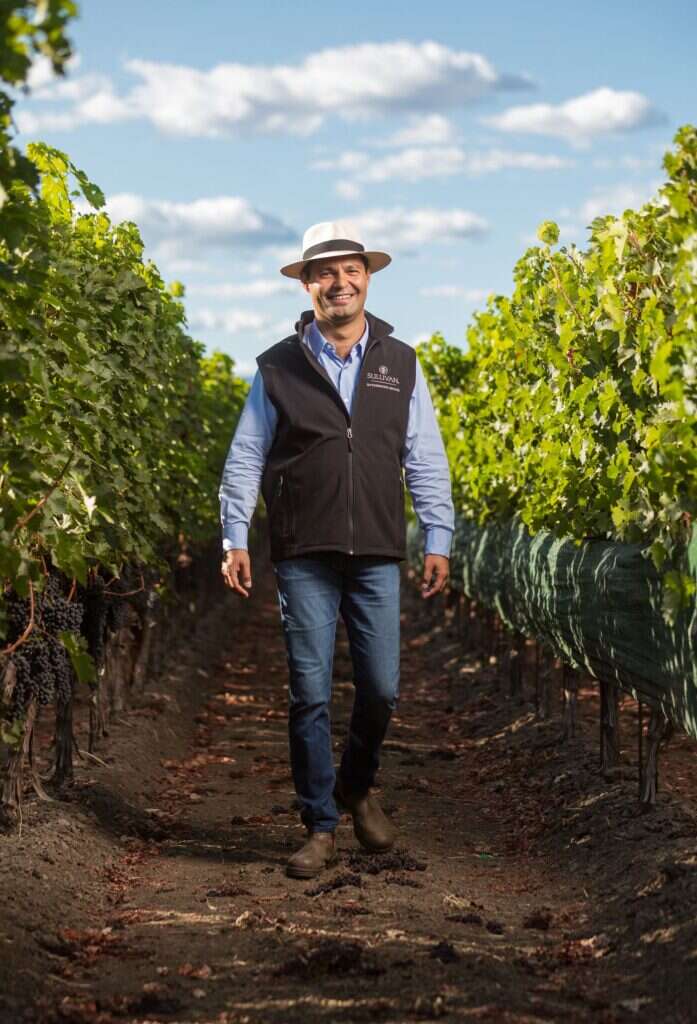
Boisset caused quite a splash in Napa—a reversal of images of the sober French among flamboyant Napans. Europe is used to royal weddings, but Americans aren’t, so when Boisset married wine heiress Gina Gallo in 2009, promptly began having progeny (twins, of course), and moved into Robert Mondavi and Margrit Biever’s old mansion atop a Napa knoll, it certainly raised eyebrows and made headlines. “I first came to Napa Valley when I was 11 years old in the early 1980s,” Boisset told me in a 2015 interview, “and I was inspired by this amazing place—its beauty, its possibilities, its people. I knew I could not be in California and not be in Napa Valley.”
Robin Williams did not make wine at his Mount Veeder estate, instead selling grapes from vines planted in the 1990s. “As you know, we are dry-farming, organic- and biodynamic- certified since the 2018 vintage,” says Justine Tesseron, who manages the Bordeaux and Napa estates with her uncle, Alfred. “We do not have any winery on site; we are renting a place. But we are working on a big project to build one in the future.”
The up-valley Sullivan property had produced excellent Cabernets but was in financial difficulties when a group led by Torres-Padilla purchased it. “I spent half my life in France,” he says, and he became interested in its wines and wine regions. “In 2006, I visited Domaine de la Romanée-Conti and was hosted by Aubert [de Villaine],” he says. “I thought to myself, why don’t I make this my life’s project?” In Napa Valley, he says, he found “the perfect blend of Old World atmosphere and New World love of technology.”
Christian Seely, who oversees all of the AXA Millésimes properties from its Château Pichon Baron, says, “Our underlying principle is to find a great terroir, one among the best in its category, and look after it as a long-term investment. I had one or two people helping me in Napa, and I spent a couple of years personally looking at many properties. I also talked with other French owners of Napa Valley properties. Christian Moueix was particularly helpful, as he always is.” While most French-owned Napa vineyards are on the valley floor, AXA’s aptly named Outpost is perched high on Howell Mountain. (Recently, Seely and AXA purchased a Pinot Noir outpost, Platt Vineyard, in coastal Sonoma.)
As Florence Cathiard says, she and Daniel purchased a great property at a lousy time. “When we bought the estate in January 2020, we had a lot of problems, starting with the fact that at first we couldn’t come back to California due to the travel ban, and [also in 2020] the Glass Fire really frightened us and came as close as 3 miles [5km] from the estate just before our first harvest.” But the Cathiards are talented and determined owners. “During this year’s en primeur campaign, we split our forces,” she says. “Ludovic [Fradin], my commercial director, and I were focused on the release pricing, while Daniel et Fabien [Teitgen] flew to California to deal with everything there—the wine and the works in progress to have the winery open to the public soon. Of course, we would have each other on the phone every single day to discuss how things are going each side of the Atlantic.”
Rob McMillan, head of Silicon Valley’s Wine Division, thinks the paranoia French winegrowers experienced following the Judgment of Paris debacle has been replaced by something much more positive: “The teacher has become the pupil.”
Yesterday, today, and tomorrow
Then there was the one that got away: the heralded French buyout that never happened. “Following months of industry rumors and speculation, the owners of Calistoga’s Chateau Montelena Winery have sold their respected 40,000-case operation to a revered second-growth Bordeaux wine estate, Château Cos d’Estournel,” reported the Napa Valley Register the morning of July 23, 2008. Then on September 15, the stock-market crash and banking crisis of 2008 culminated in the collapse of Lehmann Brothers, the bank thought to be too big to fail. By November 6, Montelena announced that the deal with Cos’s owner Michel Reybier was dead.
Ten years later, I talked with Bo Barrett, long-time winemaker, co-owner of the family business, and a man who has been surprisingly underestimated through the years. What about rumors that Montelena was again up for sale? Not true, Barrett said, “even though the vultures started circling last August when my mother died.” Furthermore, “They’ve got all the money in the world, and they want what I’ve got. But I don’t want what they’ve got.” Barrett went on to explain that to his father, Jim Barrett, the Cos buyout represented “the deal of a lifetime.” Jim Barrett died four years later, and, Bo says, the company was now being run by him, his four siblings, and his father’s second wife. How had things changed at Montelena? I asked. “For one thing,” Barrett said with a laugh, “we switched from being a kingdom and became a republic.”
If Barrett ever changes his mind, banker McMillan reports people are still looking for properties, including French winegrowers—perhaps better characterized in many cases as angels flown down from heaven rather than circling vultures. “Where there are sellers, there are buyers,” McMillan says.
Looking back over the half-century—not that long ago, really—since Bernard Portet drove down Silverado Trail and found his spot to build a winery, there are a number of observations that can be made about the French presence in Napa Valley. First, in the parlance of today’s culture wars, was theirs an unwelcomed act of outside appropriation or a respectful act of homage? From every indication, winegrowers in Napa Valley have overwhelmingly viewed the French invasion as an honor—a continuing recognition that says, “You’re doing something outstanding here, and we would like to participate.”
That doesn’t mean that the French are immune from criticism or that cultural differences and practices can’t be pointed out. In fact, the French are sometimes the first to do so. “The advantage of the US is that the winemaker feels more freedom, more power,” says Bascaules. “In our minds, [in Napa] we think we can do anything. In France, we tend to accept our limitations, and I’m not sure that’s a good thing.”
Guillaume Boudet finished college in France in 2013, and within a decade he is now winemaker at Hyde de Villaine in Napa Valley. “It was my little American dream,” he says, “being in the right place at the right time. In France, it would have taken maybe 20 years to climb the ladder to winemaker.” At the same time, he sees benefits in his French heritage, noting the difference between himself and graduates of University of California at Davis. “Davis is more about looking at the numbers and the chemistry,” he says. “In Bordeaux, we have the same technology, but we’re more old-school, observing, tasting, rather than purely relying on numbers, especially at harvest.”
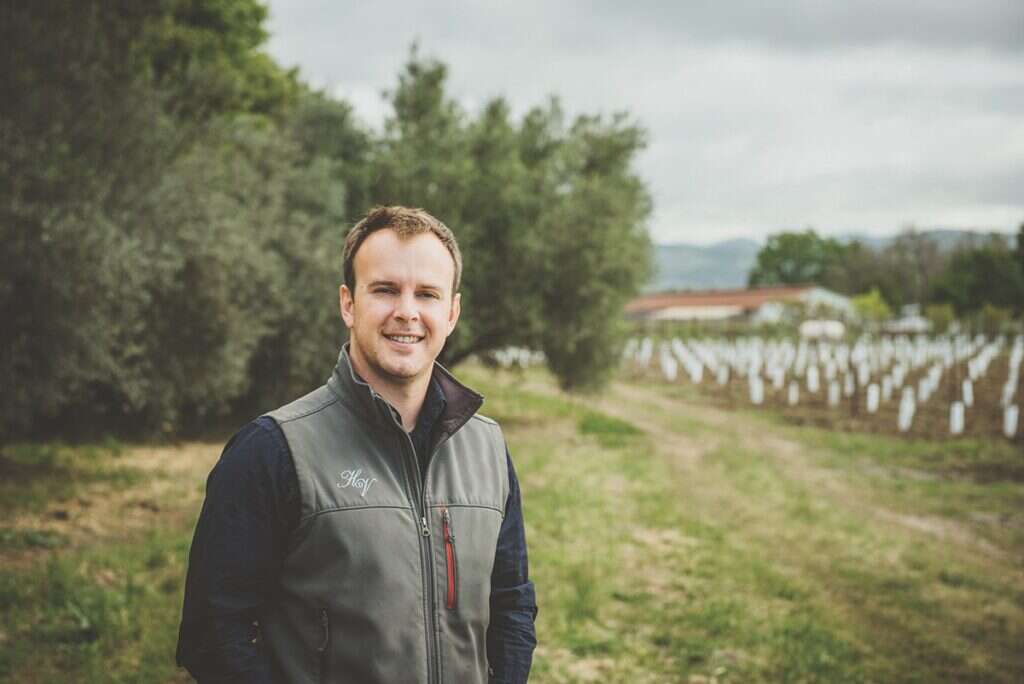
Aaron Pott learned winemaking in the US, then, aided by introductions from Rolland, became head of winemaking at an early age at Château Troplong-Mondot, before returning to California to consult and set up his own winery, Pott Wine. “The French-owned wineries that work the best are the ones that create collaborations with American entities already in existence,” he says. “Many French groups come into Napa Valley trying to use Bordeaux methods to create wines. One notable exception is Pym-Rae, owned by the Tesseron family, who hired Thomas Comme, who wanted to find the true terroir of their little Mount Veeder plot. He realized that due to the lack of water, dry-farming was going to be a big part of that. He worked with many people that had dry-farmed in Napa before and managed to do a good job of it.”
But, as Rolland points out, there is less difference today worldwide in the tools and practices winemakers have. Wine tourism in Bordeaux is not so different than wine tourism in California. The once-sacrosanct Place de Bordeaux now trades in wines from California (and any region producing high-scoring wines). True, France has in place protections that would prevent a wine Americanization of France, as Robert Mondavi found in his failed campaign in Languedoc. But one part of French culture remains—not tipping your hand, even to your best neighbors. “We really got closer to other French owners in Napa once we bought the estate, but not before, as we had to keep the secrecy,” Florence Cathiard says.
So, have potential investors sought their counsel? “I think every Bordeaux potential investor in Napa is trying to move discreetly, so we would not know about it before a deal is done and published in the media. For example, we are really close with Pierre Lurton, but I learned about Phelps just as the deal was signed with LVMH,” she says, adding, “Sorry to bust a myth, but there is no ‘Napa French Connection.’” Whoever the next French buyer will be, and which property will be purchased, will remain a mystery.
Before he became US president, Thomas Jefferson was ambassador to France, traveling to Bordeaux in 1787 to buy wine. While there, he noted the large number of Irish expats in the French wine business, citing in his notebooks “Gernon, Barton, Johnston, Foster, Skinner, Copinger, and McCarthy.” The names Kirwin, Clarke, Dillon, Pheland, and Lynch might also have been added. History has referred to this influential group of Irish invaders of Bordeaux as “The Wine Geese” (see WFW 68, pp.142–47). As the Frenchification of Napa Valley continues, one only has to keep an eye on the headlines to see today’s version of the wine geese—“Les Oiseaux du Vin”—circling above Napa Valley, looking for the next promising spot to land.






